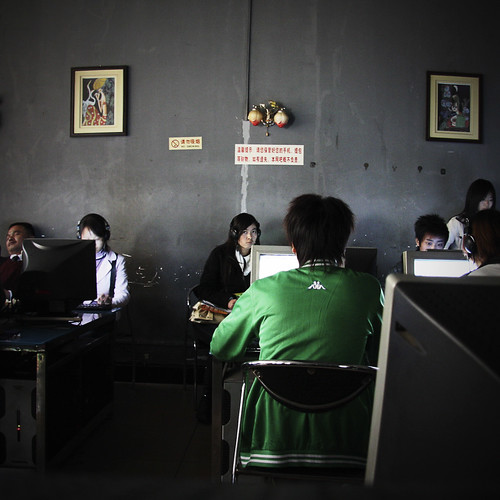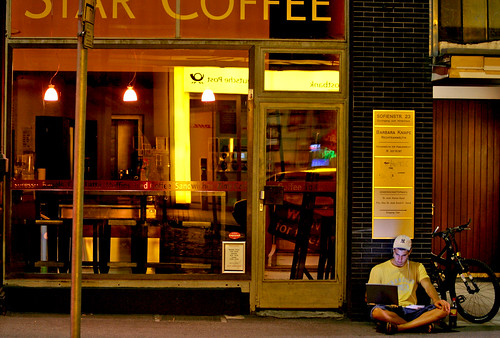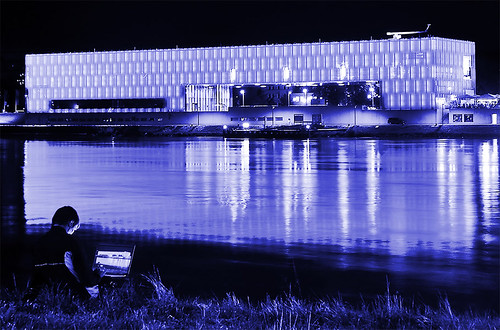Cities for Cyborgs: 10 Rules
This is a guest post by Keiichi Matsuda, who is a freelance designer and filmmaker. You might know him as the creator of the Augmented (hyper)Reality videos: Domestic Robocop and Augmented City (3d glasses suggested). If you didn't, now's a good time to find out.
Imagine the cyborg an augmented ape, a technologically enhanced being. It invents and uses technologies to extend its nervous system, its reach and influence: cellphones / computers / the internet / communications infrastructures / transport / TV / pharmaceuticals / weapons / politics / printing / money / standardised time. It is shaped and defined by its tools; developing new technologies allows it to reach and explore new territories and perspectives.

 photo credit: Marc oh!The premise of the cyborg infers that posthuman evolution is taking place with every new technology; that the human being is in a constant state of flux, changing shape as technology advances. We are at point X in a continuum of cybernetic evolution, and will continue to evolve according to the pace of technological innovation. Our particular genus is distinct in behaviour from even the cyborg of a decade ago, and the cyborg of 20 years ago is further removed still.The latest model of cyborg, CY-2010, is of genus electronomad. It shares characteristics and is built on similar tools as its predecessors, but the important additions of mobile technology, WiFi and the cloud have made it more mobile, more agile. It is finding new ways to inhabit and use the city, and the city is adapting to support it. This is a practical mini-guide for designing the cities of today’s cyborg.
photo credit: Marc oh!The premise of the cyborg infers that posthuman evolution is taking place with every new technology; that the human being is in a constant state of flux, changing shape as technology advances. We are at point X in a continuum of cybernetic evolution, and will continue to evolve according to the pace of technological innovation. Our particular genus is distinct in behaviour from even the cyborg of a decade ago, and the cyborg of 20 years ago is further removed still.The latest model of cyborg, CY-2010, is of genus electronomad. It shares characteristics and is built on similar tools as its predecessors, but the important additions of mobile technology, WiFi and the cloud have made it more mobile, more agile. It is finding new ways to inhabit and use the city, and the city is adapting to support it. This is a practical mini-guide for designing the cities of today’s cyborg.
 photo credit: lanier67
photo credit: lanier67
Cities for Cyborgs: 10 Rules
- Deprogramme. Spaces do not define the CY-2010; the CY-2010 defines space. Any waiting room, park, coffee shop or train carriage can become its office, cinema, concert hall or game centre. Interior and exterior matter little to it, as do zoning, demarcation, and programming of space. While some programming is still necessary (there is no working prototype for a toilet or brain surgery app), labels such as ‘dining room’, ‘conference room’, ‘library’ and ‘shop’ are becoming increasingly unwieldy. The next genus will dispense of programme to an even greater degree, so deprogramme your city now.
- Don't be boring. Rule 1 is not an excuse for bland uninspiring architecture. The CY-2010 enjoys the physical city, so use your new-found freedom from function to build something fun and exciting.
- Design with fields, not walls. The CY-2010 responds not according to the layout of rooms and corridors, but in to liquid fields of presence. Shelter / warmth / HVAC / light / mobile signal / 3G / WiFi / seating / caffeine / alcohol / smoking / no smoking / quiet zone / childrens area / are the criteria that define its occupation of the city. These elements can be instantaneously adjusted with signs and switches.
- More power sockets, public toilets and coin lockers.
- Home and work are not architectural conditions. The CY-2010 cannot distinguish between these things. Its offices are located in its dwelling, in pubs, bars, parks, and likewise its traditional workplaces are now also used for communicating with friends, watching videos, and reading blogs about cyborgs. The separate spheres of home/private/woman and work/public/man defined during the industrial revolution are merging, so put some home in its offices and some office in its homes.
- Public and private are not architectural conditions. The CY-2010 already has a sophisticated set of filters and controls that allow it to set its own level of privacy on the network. In space, it can create a spontaneous personal field of privacy by connecting headphones and burying its head in a newspaper. Previously private activities are also being reclassified as public; you can now witness CY-2010s making private phone calls on the bus, or grooming in the reflections of shop windows. The CY-2010’s sense of privacy is defined by limiting incoming and outgoing signals; not just through architectural intervention, but also through sensory occlusion.
- Service the CY-2010. Alcohol / nicotine / caffeine / protein / codeine / components / carbohydrates / carbonation / cocaine / glucose / sucrose / fatty acids / antibiotics / direct current / are input, and urine / faeces / heat / blood / plastic / vomit / cardboard / are output (see [4]).
- Create public spaces. The CY-2010 produces and broadcasts, it is both the consumer and the consumable. It interacts constantly with its peers, and forms complex and disparate social groups. The amount of connections the CY-2010 makes is more than it is able to keep track of internally, so it uses online memory, ‘social networks’, to manage, organise and communicate. Contacts are assigned numbers and handles, and communications are often limited to 140 characters to prevent cognitive overloading. Cities must provide ample public loitering and seating areas to allow CY-2010s to communicate over the network.
- Create events. The CY-2010 is social in meatspace too. It enjoys being in a crowd, and feeling the energy of other beings. Although it can access limitless entertainment over the network, and communicate over vast distances, it also understands the value of the visceral and the now. The CY-2010 will go to a concert and listen to recorded music, watch a giant suspended TV screen at a game instead of the tiny players below it, or join a march with nothing to protest. These are not contradictions.
- Understand mediation. The CY-2010 consumes physical and virtual space indiscriminately, so the augmented layers of the city are as important as their built counterparts. The built environment must be designed to support and accommodate the virtual application of meaning, speaking to both the naked ape and the devices that comprise the CY-2010.

 photo credit: x-hibitImagine the city. It is the habitat of the cyborg, and is built to support the activities of its inhabitants - as the cyborg is constantly evolving, so too must our built infrastructure. We must ensure the compatibility of our cities for CY-2010 and forthcoming models, and stop creating redundant and limiting spaces that answer to an older genus. We have the opportunity now to create a city that is tuned to our occupation of it, not through megastructures and skyscrapers, but through infrastructure and technological integration. This requires an understanding of the cybernetic occupation of the city; we can abandon fixed utopias and start to understand the cyborg and the city as organic entities that can never be completed or perfected. This is the challenge that the city is facing now: it can be an exciting, inspirational and joyful space that enriches and supports life, but it is up to us, the CY-2010, to make it a reality.This is one of 50 posts about cyborgs a project to commemorate the 50th anniversary of the coining of the term.
photo credit: x-hibitImagine the city. It is the habitat of the cyborg, and is built to support the activities of its inhabitants - as the cyborg is constantly evolving, so too must our built infrastructure. We must ensure the compatibility of our cities for CY-2010 and forthcoming models, and stop creating redundant and limiting spaces that answer to an older genus. We have the opportunity now to create a city that is tuned to our occupation of it, not through megastructures and skyscrapers, but through infrastructure and technological integration. This requires an understanding of the cybernetic occupation of the city; we can abandon fixed utopias and start to understand the cyborg and the city as organic entities that can never be completed or perfected. This is the challenge that the city is facing now: it can be an exciting, inspirational and joyful space that enriches and supports life, but it is up to us, the CY-2010, to make it a reality.This is one of 50 posts about cyborgs a project to commemorate the 50th anniversary of the coining of the term.